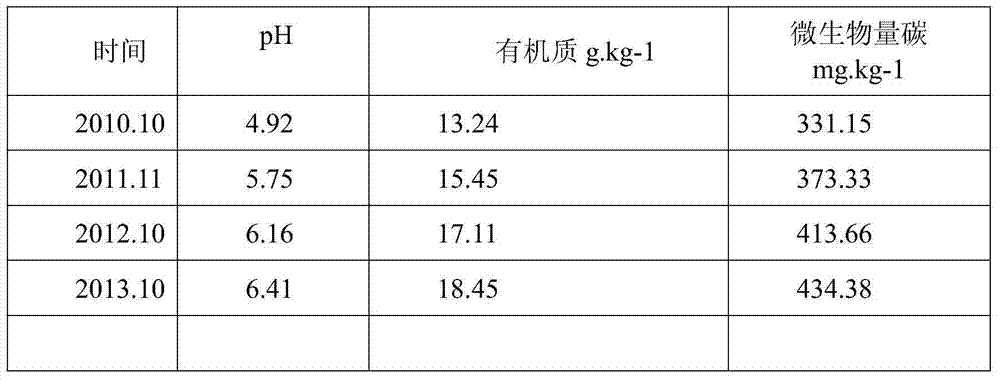Method for improving acidified soil
A soil acidification and waste technology, applied in the biological field of chemical combined restoration, physics, and soil acidification improvement, to achieve the effects of increasing diversity, enhancing the ability to absorb and store nutrients, and have a wide range of sources.
- Summary
- Abstract
- Description
- Claims
- Application Information
AI Technical Summary
Problems solved by technology
Method used
Image
Examples
Embodiment 1
[0018] Soil acidification improvement in paddy fields, the specific steps are as follows:
[0019] 1. Site selection: For example, double-cropping rice field in winter in northern Hunan.
[0020] 2. Stockpile components: The stockpile components are: 35% of tea residue, 35% of cow dung, 8% of plant ash, 20% of milk vetch straw, 1% of vermiculite, and 1% of calcium magnesium phosphate fertilizer. Various raw materials are mixed evenly.
[0021] 3. Stacking: Interplant milk vetch before the late rice harvest in early October. After the late rice is harvested, choose when the ground is relatively moist but not waterlogged, and pile up tea dregs, cow dung, plant ash, etc. to form a mixture. The height of the pile should be about 80cm. After cutting part of the milk vetch stalks, cover the top of the pile with another layer to shade, so as to reduce the loss of water evaporation and ammonia volatilization. Stack it for about 5 days, turn it over once, add water according to the d...
Embodiment 2
[0028] Citrus orchard acidification soil improvement, the specific steps are as follows:
[0029] 1. Site selection: severely acidified citrus orchards.
[0030] 2. Stacking configuration: The stacking composition is: 45% of tea residue, 30% of cow dung, 8% of plant ash, 15% of peanut straw, 1% of vermiculite, and 1% of calcium magnesium phosphate fertilizer. Various raw materials are mixed evenly.
[0031] 3. Stacking: Plant peanuts in the open space under the citrus trees in April of that year. In June, mix and pile tea dregs, cow dung, and plant ash on the open space. After cutting the upper part of the peanuts, mix the straw into the mixture. 50-80cm, the top of the pile is covered with a layer of peanut straw to shade, so as to reduce the loss of water evaporation and ammonia volatilization. After stacking for about 10 days, turn it over once, add water according to the degree of dryness and wetness of the compost, stack it for about 20 days, then add water and turn it ...
Embodiment 3
[0038] Acidified soil improvement in corn fields, the specific steps are as follows:
[0039] 1. Site selection: corn field; between corn rows.
[0040] 2. Stacking configuration: The stacking composition is: 40% of tea residue, 30% of cow dung, 20% of plant ash, 8% of peanut straw, 1% of vermiculite, and 1% of calcium magnesium phosphate fertilizer. Various raw materials are mixed evenly.
[0041] 3. Stacking: plant peanuts among the corn rows in April of that year, and pile up tea dregs and cow dung between the corn rows in June, and mix the straw into the mixture after cutting the upper parts of the peanuts, which should be stacked high The top of the pile is covered with a layer of peanut stalks for shading, so as to reduce the loss of water evaporation and ammonia volatilization. Stack it for about 5 days, turn it over once, add water according to the degree of dryness and wetness of the compost, stack it for about 20 days, then add water and turn it once.
[0042] 4. ...
PUM
 Login to View More
Login to View More Abstract
Description
Claims
Application Information
 Login to View More
Login to View More - R&D
- Intellectual Property
- Life Sciences
- Materials
- Tech Scout
- Unparalleled Data Quality
- Higher Quality Content
- 60% Fewer Hallucinations
Browse by: Latest US Patents, China's latest patents, Technical Efficacy Thesaurus, Application Domain, Technology Topic, Popular Technical Reports.
© 2025 PatSnap. All rights reserved.Legal|Privacy policy|Modern Slavery Act Transparency Statement|Sitemap|About US| Contact US: help@patsnap.com



